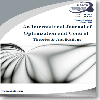An application of fuzzy linear modeling: prediction of uncertainty for betaglucan content
An application of fuzzy linear modeling: prediction of uncertainty for betaglucan content
___
- [1] Mantovani, M.S., Bellini, M.F., Angeli, J.P.F., Oliveira, R.J., Silva, A.F. & Ribeiro, L.R. (2008). -Glucans in promoting health: Prevention against mutation and cancer. Mutation Research 658, 154– 161.
- [2] Chen, J. & Raymond, K. (2008). Beta-glucans in the treatment of diabetes and associated cardiovascular risks. Vasc. Health Risk Manag. 4(6): 1265–1272.
- [3] Magnani, M., Gomez, R.J.H.C, Mori M.P., Kuasne, H., Gregorio, E.P., Libos, F.Jr. & Colus, I.M.S. (2011). Protective effect of carboxymethyl-glucan (CM-G) against DNA damage in patients with advanced prostate cancer. Genet. Mol. Biol. 34(1), 131–135.
- [4] Satrapai, S. & Suphantharika, M. (2007). Influence of spent brewer’s yeast -glucan on gelatinization and retrogradation of rice starch. Carbohyd. Polym. 67:500-510.
- [5] Hahn-Hägerdal, B., Karhumaa, K., Larsson, C.U., Gorwa-Grauslund, M., Görgens, J. & van Zyl, W.H. (2005). Role of cultivation media in the development of yeast strains for large scale industrial use. Microbial Cell Factories, 4:31, 1-16.
- [6] Naruemon, M., Romanee, S., Cheunjit, P., Xiao, H., Mclandsborough, L.A. & Pawadee, M., (2013). Influence of additives on Saccharomyces cerevisiae β-Glucan production, International Food Research Journal, 20, 1953-1959.
- [7] Sabuncu, N. (2016). -glukan içeriğinin arttırılması için S.cerevisiae üretilen bir biyoreaktörde çoğalma koşullarının incelenmesi ve pH kontrolü. Master Thesis. Ankara University.
- [8] Aguilar-Uscanga, B. & François, J.M. (2003). A study of the yeast cell wall composition and structure in response to growth conditions and mode of cultivation, Letters in Applied Microbiology, 37, 268–274.
- [9] Klis, F.M., Boorsma, A. & De Groot, P.W.J. (2006). Cell wall construction in Saccharomyces cerevisiae. Yeast, 23, 185–202.
- [10] Javmen, A., Grigiskis, S. & Gliebute, R. (2012). βglucan extraction from Saccharomyces cerevisiae yeast using Actinomyces rutgersensis 88 yeast lyzing enzymatic complex. Biologija. 58(2), 51–59.
- [11] Lee, J.N., Lee, D.Y., Ji, I.H., Kim, G.E., Kim, H.N., Shon, J., Kim, S. & Kim, C.W. (2001) Purification of Soluble β-Glucan with Immune-enhancing Activity from the Cell Wall of Yeast. Bioscience, Biotechnology, and Biochemistry. 65(4), 837-841.
- [12] Hunter, K. W. Jr., Gault, R. A. & Berner, M. D. (2002). Preparation of microparticulate β‐glucan from Saccharomyces cerevisiae for use in immune potentiation. Letters in Applied Microbiology, 35(4), 267-271.
- [13] Pelizon, A. C., Kaneno, R., Soares, A. M. V. C., Meira, D. A. & Sartori, A. (2005). Immunomodulatory activities associated with βglucan derived from Saccharomyces cerevisiae. Physiological Research, 54(5), 557-564.
- [14] Shokri, H., Asadi, F. & Khosravi, A. R. (2008). Isolation of β-glucan from the cell wall of Saccharomyces cerevisiae. Natural Product Research, 22(5), 414-421.
- [15] Wenger, M. D., DePhillips, P. & Bracewell, D. G. (2008). A microscale yeast cell disruption technique for integrated process development strategies. Biotechnology Progress, 24(3), 606-614.
- [16] Freimund, S., Sauter, M., Kappeli, O. & Dutler, H. (2003). A new non-degrading isolation process for 1,3- β-D-glucan of high purity from baker’s yeast Saccharomyces cerevisiae. Carbohydrate Polymers. 54, 159–171.
- [17] Box, G.E.P. & Draper, N.R. (2007). Response Surface Mixtures and Ridge Analysis. John Wiley and Sons, New Jersey.
- [18] Khuiri, A.I. & Cornell, J.A. (1996). Response Surfaces: Desings and Analysis, Marcel Dekker, New York.[19] Zadeh, L.A. (1965). Fuzzy sets. Information Control, 338-353.
- [20] Bashiri, M. & Hosseininezhad, S.J. (2009). A Fuzzy Programming for Optimizing Multi Response Surface in Robust Designs. Journal of Uncertain Systems, 3(3), 163-173.
- [21] Bashiri, M. & Hosseininezhad, S.J. (2012). Fuzzy Development of Multiple Response Optimization. Group Decision and Negotiation, 21(3), 417-438.
- [22] Türkşen, Ö. & Apaydın, A. (2014). A Modeling Approach Based on Fuzzy Least Squares Method for Multi-Response Experiments with Replicated Measures. Chaos, Complexity and Leadership 2012 Springer Proceedings in Complexity, Springer Netherlands, 153-158.
- [23] Türkşen, Ö. & Güler, N. (2015). Comparison of fuzzy logic based models for the multi-response surface problems with replicated response measures. Applied Soft Computing, 37, 887-896.
- [24] Türkşen, Ö. (2016). Analysis of Response Surface Model Parameters with Bayesian Approach and Fuzzy Approach. International Journal of Uncertainty, Fuzziness and Knowledge-Based Systems, 24(1), 109−122.
- [25] Türkşen, Ö. (2018). A Fuzzy Modeling Approach for Replicated Response Measures Based on Fuzzification of Replications with Descriptive Statistics and Golden Ratio. Süleyman Demirel University Journal of Natural and Applied Sciences, 22(1), 153-159.
- [26] Mendel, J.M. (2017). Type-1 Fuzzy Sets and Fuzzy Logic. Uncertain Rule-Based Fuzzy Systems, Springer International Publishing AG, 25-99.
- [27] Lai, Y.J. Hwang, C.L. (1992). Fuzzy Mathematical Programming. Springer Verlag, Berlin.
- ISSN: 2146-0957
- Yayın Aralığı: 4
- Yayıncı: Prof. Dr. Ramazan YAMAN
An application of fuzzy linear modeling: prediction of uncertainty for betaglucan content
On the explicit solutions of fractional Bagley-Torvik equation arises in engineering
Munevver TEZER SEZGİN, Cemre AYDİN
Investment evaluation of wind turbine relocation
Sakir SAKARYA, Hasan Huseyin YİLDİRİM
Approximate controllability of nonlocal non-autonomous Sobolev type evolution equations
Arshi MERAJ, Dwijendra NARAIN PANDEY
Ana R.M. CARVALHO, Carla M.A. PINTO, Jo˜ao Nuno TAVARES
A comparison of some control strategies for a non-integer order tuberculosis model
A Boiti-Leon Pimpinelli equations with time-conformable derivative
Kamal Ait TOUCHENT, Zakia HAMMOUCH, Toufi MEKKAOUI, Canan UNLU
Ilker KUCUKOGLU, Tulin GUNDUZ, Fatma BALKANCİOGLU, Emine CHOUSEIN TOPAL, Oznur SAYİM
